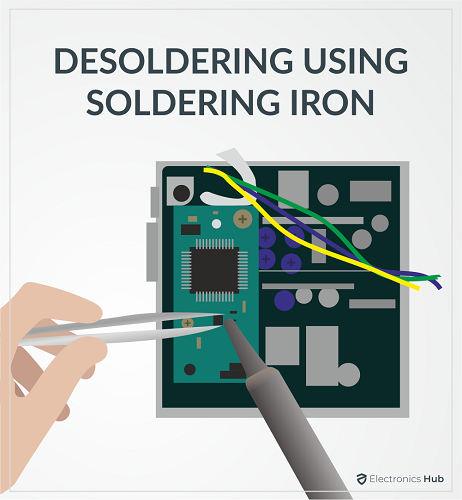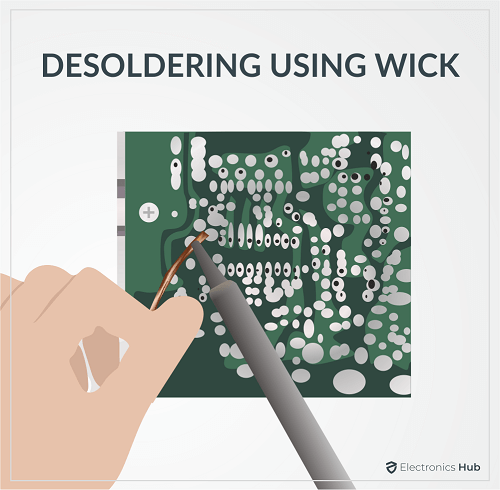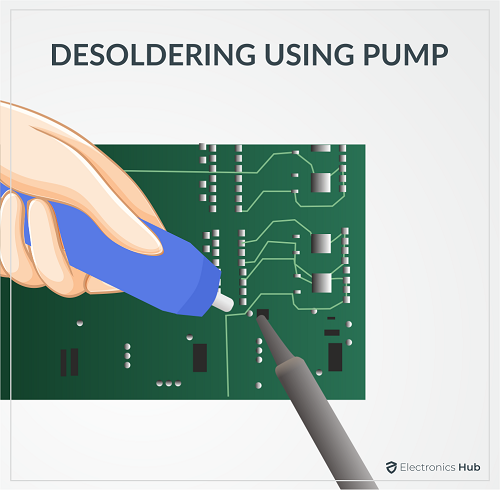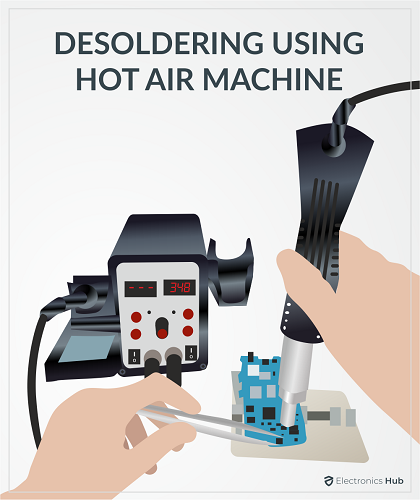But what happens if you solder an incorrect component or pipe. Or there is no use for the soldered component/pipe and you want to use it for a different purpose. Simple. You remove the component/pipe by melting the solder and desoldering the soldered joint. When desoldering, you have to choose the correct method and tool to remove the components. Only then, you will be able to re-use the components. Otherwise, the components will get damaged in the process and you won’t be able to use them anymore. The following article explains the process of desoldering in detail and the different desoldering methods you can use to remove the components. Check out the best desoldering stations
What is Desoldering?
Desoldering is the process of melting the solder and removing the joints made between two materials. In electronics, it refers to the removal of electrical components from PCB for troubleshooting, repairing, replacing, and salvaging. Desoldering is most commonly used for this purpose. To put it in simple terms, desoldering is the exact opposite of soldering. You undo everything that you did in the soldering process. Like soldering, desoldering is also an intricate process and requires some level of proficiency. You have to follow similar steps and adhere to strict safety measures as in the case of soldering.
Methods of Desoldering
There is more than one method of desoldering. Each one requires different tools and different levels of proficiency in soldering. Below is a comprehensive list of different methods you can use to desolder components.
Using a Soldering Iron
Soldering iron is the simplest and easiest method to desolder components. You do not need any other tools apart from the soldering iron and a pair of fliers. Here is what you have to do,
Put the Soldering Iron at an optimum temperature that can melt the solder. Heat the solder joint using the soldering iron until it starts to melt. Nudge the pins using the iron and move the solder away from the joints. Pull the components using pliers to remove them from the pinholes. While pulling the components, apply pressure at the tips instead of their bodies. Otherwise, the components may get damaged.
If you want to remove solder from holes, stick a safety pin inside the hole. This will suck the solder and help you to remove them easily. Pros
You only need a soldering iron to perform desoldering. You can reuse the desoldered components.
Cons
If you use the soldering iron for too long, you may damage the component or the board.
Using a Soldering Wick
The soldering wick method is used to remove unwanted solder after the process of soldering. Soldering wick is made by braiding and intertwining copper coils together. Hence, it is also known as a desoldering braid. Copper wires are used to make the soldering wick because they are good conductors of heat. As solder is attracted to heat, the copper coils suck up the solder from the metal surface. Some soldering wicks come with flux which makes it easier to remove the solder from the surface. If your solder wick does not have flux, you can dip the end of the wick into some flux to enhance the speed of solder removal. Here is what you have to do to remove the solder,
Intertwine a few inches of copper wires and form a braid. Apply some flux on the copper braid by dipping the end into flux. Place a portion of the solder wick on the joint you want to desolder. Keep a hot soldering iron at the tip of the solder wick and the desired pin. Wait for a few seconds until the solder melts and the solder wick sucks the melted solder. Take the solder wick and remove the portion of the wick that is covered with solder. Now, repeat the same process until you remove all the unwanted solder.
While handling the solder wick, ensure that you do not touch it using your hands as it will be very hot. Use a pair of pliers to hold and position it. Pros
The method is cheap, simple, and easy to use. The method is great for removing solder from flat surfaces. You can modify the size of the soldering wick depending on the amount of solder you want to remove. You can reuse the desoldered components.
Cons
You can not reuse the soldering wick. You have to cut the portion covered in solder. As the soldering wick gets very hot, it can be difficult to position it against the joint. It is difficult to remove solder from pinholes using this method.
Using a Desoldering Pump
In this method, you use a desoldering pump to suck the solder. A desoldering pump is basically a small, high-pressure vacuum pump. Before using the pump to suck the solder, you have to heat and melt the solder. Here are the steps to use the desoldering pump to remove the solder,
Use a soldering iron to heat the solder until it melts. Squeeze the bulb or press down the plunger of the desoldering pump and place it on the molten solder. Release the bulb to suck up the solder. Some desoldering pumps will have a release button so that you do not have to keep squeezing the bulb. Remove the desoldered components. Repeat the same steps until you remove the excess solder.
Some desoldering pumps come with a soldering iron so that you do not have to get one separately. You can dispose of the solder in the desoldering pump by repeatedly squeezing and releasing the bulb. Pros
Desoldering pumps come in different styles and operating mechanisms for your ease of use. The method is great for removing solder from pinholes and desoldering small components. You can reuse the desoldered components.
Cons
Most desoldering pumps are large. So, you will find it difficult to get them into tight spaces.
Using a Heat Gun (Hot Air Machine)
A heat gun works in the same way as a soldering iron. It heats up the solder so that you can remove the components. You can also use a hot air station instead of a heat gun. It is very effective but at the same, it is also expensive. Here is how to desolder components using a heat gun,
Turn on the heat gun. Hold the PCB firmly using a stand or pliers. Hold the tip of the heat gun against the solder until it melts. Remove the components using a pair of pliers.
When using the heat gun, ensure that you do not hold it against the board for too long. Otherwise, you will melt or damage the board. Pros
You can desolder and remove the components in a few seconds. You can reuse the desoldered components.
Cons
As it heats the components very quickly, it damages the components in most cases and makes them unusable. In some cases, it also damages the board. If you are not careful, you can injure yourself as well during the process.
Using Compressed Air
You can use compressed air to desolder and remove components in two different ways. The first one requires a soldering iron. But the second one does not. In both methods, you have to use a compressed air gun to discharge compressed air and blast the molten solder. When using the compressed air method, you have to wear safety glasses and other protective gear. As it blasts the molten solder, the solder chunks can hit your body leading to injuries.
Option 1: With a Soldering Iron
Here is how to use compressed air to desolder components with the help of a soldering iron,
Use the soldering iron to heat the solder until it melts. Bring the tip of the compressed air gun close to the molten solder. Turn on the compressed air gun and blast the molten solder.
Pros
This method is fun, quick, and easy. You can easily remove solder from pinholes by blasting air. You can reuse the removed components.
Cons
The solder will fall all over the board and workspace, creating a mess. It can lead to injuries if you do not use protective gear.
Option 2: Without a soldering iron
As mentioned already, you do not need a soldering iron in this method. It is a more aggressive method than the previous one. When you invert a compressed air can, it sprays out a freezing liquid solvent. This super-cools the solder making it brittle and easy to destroy. Here is how to do it,
Take a compressed air can and turn it upside down. Spray it on the solder and the joints. Wait for a few minutes. Pull the components using a pair of pliers.
If you do not have pliers, you can break the joint and then remove the components. Pros
You do not need a soldering iron or any other tool apart from a compressed air can. It is the only method that does not involve heating the solder.
Cons
In most cases, the process will damage the components and you can not reuse them.
Safety Tips for Desoldering
Just like in soldering, you have to strictly adhere to safety precautions while desoldering as well. If not, it can lead to serious injuries. Follow our safety tips to have a good and safe desoldering experience.
Desolder in well-ventilated areas. Do not touch the tip or element of a soldering iron. Keep the soldering iron in its stand after use. Handle the components using a pair of pliers while desoldering. Do not touch the solder using your hands. Wear safety glasses, masks, and gloves. Avoid wearing loose-fitting clothes. Keep a first aid kit and fire extinguisher ready.
How to solder copper pipe? How to remove solder? How to clean soldering iron? How hot does a soldering iron get?
Also, if you are repairing a product and you want to replace a faulty or damaged component, you have to remove the existing components by desoldering it and then solder its replacement. Comment * Name * Email * Website
Δ









![]()